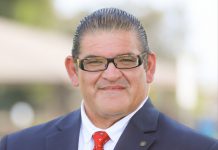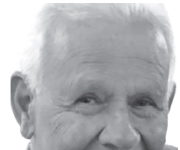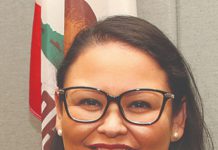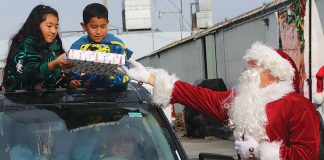
The Japanese love cherry blossoms both for their beauty and as harbingers of spring, but also because their short life reminds us of the transience of life.
Sweet but sad.
In the 1920s the Pajaro Valley Japanese community donated and planted hundreds of cherry blossom trees throughout Watsonville as a gesture of gratitude for the hospitality they had received since first arriving in the 1890s.
In just three days, April 27-29, 1942, the Japanese community was uprooted by the American government and taken away to prison. Not because they had committed any crimes, but simply because they happened to look like the pilots flying the airplanes ravaging the Pacific. The majority of the 1,200 who boarded the buses headed for the Salinas rodeo grounds were U.S. Citizens.
When the Japanese community returned in 1945, they found that most of the cherry trees had been vandalized and were dead. They knew the vandalism did not represent the feelings of many Watsonvillans. And the Japanese started over, most from nothing, becoming the only group to be U.S. immigrants twice.
Watsonville’s native son, Mas Hashimoto, was 6 years old on that April morning when, wearing his number 12425D he boarded the bus headed for Salinas. Through all the painful memories- hastily-built barracks, the barbed wire and machine guns atop the guard towers, and the accidental death of his brother, Mas remembered the acts of kindness from his Watsonville neighbors.
In the year 2000, now a retired Watsonville High School teacher and president of the Watsonville-Santa Cruz Japanese American Citizens League (JACL) Mas wanted to remind Watsonville of both the sad and sweet of 1942.
He announced his vision to the JACL membership. On the upcoming 60th anniversary (April 27, 2002), he wanted to close Beach Street and reenact the community’s departure. A group of the Japanese descendants would walk east, check in at the Vets Hall, get their numbers, and then board a bus and drive away.
It was an absurdly complicated idea and we told him so. Shut down the street? Re-live the sadness?
And then he described the sweet. Following the reenactment, we would assemble in the Mello Center, but instead of a program about the pain and racism, we would honor those good Watsonvillans, the ones who spoke out against the removal, who took in their family pets, who protected their properties, who garaged their cars, who came to visit them in the Salinas prison camp, and later in the Poston, Arizona concentration camp. And who welcomed them home in 1945.
“We’ll honor those who did the right thing,” Mas declared.
Model the behavior you want. Emphasize the good. It was brilliant but frighteningly complex, fraught with permits and permissions. And the community’s willingness to face the tragedy again and not look away.
Mas knew Watsonville. He had helped shape its heart in his classroom. Permits? Permissions? All the approvers were his former students! Yes, certainly Mr. Hashimoto. You want to close Beach Street? For how long? Where do we sign?
A steering committee was formed (I was a proud member) and the work began. Watsonville was a perfect stage. When we looked east on Beach, despite the intervening floods and earthquake, it looked the same as it did in 1942 photographs. Stately homes on the right, Vets Hall on the left, high school on the right, Martinelli’s on the left. Except, it was in color. And, we’d have to cover the parking meters.
There was prodigious research, combing the newspapers to find those people who stood up against the fierce anti-Japanese winds fanned by the Federal Government, the Army, the FBI. We had our own army, volunteers from Cabrillo and UCSC who dug and interviewed. Most of the awardees were deceased, but we hunted down their descendants and invited them to accept the posthumous awards.
Then came the unexpected. On Sept. 11, 2001, terrorists hijacked four airliners and attacked the United States. As that terrible day unfolded we steering committee members began having doubts about the upcoming reenactment in April. Maybe we should cancel?
Later that day, it began happening again. Enraged Americans began striking out against anyone who looked like the presumed hijackers. Just as they had following Pearl Harbor, only this time the targets were Arab Americans, South Asians, Muslims, anyone resembling the perceived hijackers. Late on 9/11 the National JACL issued a statement decrying the attacks, reminding of what had happened to people of Japanese ancestry. It was wrong in 1942 and it was wrong in 2001.
Later in September, the steering committee resolved to continue working on the April 27, 2002 event. We agreed that more than ever we needed to go forward.
And we did. All the planning paid off, and as I watched it unfold, the full grandstands were quiet except for the weeping of those who had been taken away as children. Later in the Mello Center we honored many of the over 50 individuals, families, churches and businesses that had stood up and provided comfort and support when it was most difficult.
During the following months, many other JACL chapters contacted Mas, hoping to stage a similar event in their own community. Some even visited Watsonville and walked up Beach Street. So far, none of them has been able to stage a reenactment.
I believe that besides having a perfect stage on Beach St, we also had a community that was strong enough to confront the tragedy of 1942 and not turn away.
Recently we toyed with the possibility of doing something to commemorate the two anniversaries this April—the 80th of the removal and the 20th of the reenactment. But as it did with so many things, Covid-19 stole this, too.
When Mas and I discuss how unique the 2002 reenactment proved to be, Mas just smiles, shrugs and says, “Only in Watsonville.” I agree, but to myself I add that no other community has Mas Hashimoto.
Sandy Lydon grew up in Hollister and is a graduate of UC Davis (’61). This year he is celebrating his 60th year as a classroom teacher, 54 of which have been at Cabrillo College. He is a proud member of the Hollister Haybaler Hall of Fame. His column appears on this page the first Friday of each month. His views are his own and not necessarily those of the Pajaronian.












